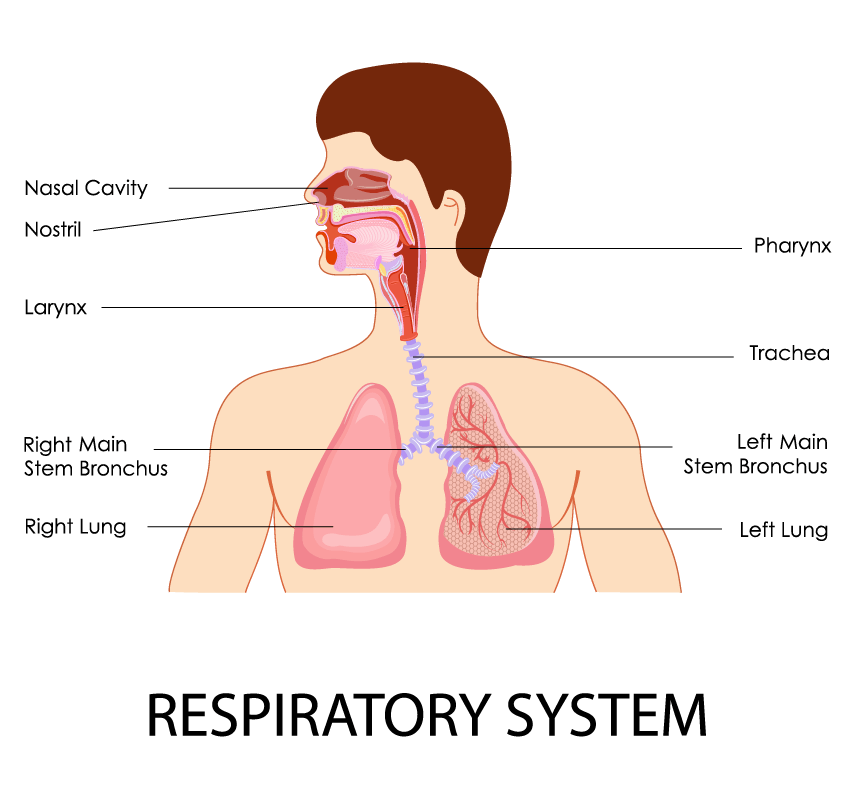Yoga for A Healthy Respiratory System
Yoga and Physiology for Optimal Health Series
by Cindy Dienhart, 500 RYT
The respiratory system is the network of organs and tissues that help you breathe. The organs and muscles associated with the respiratory system work together to move oxygen throughout the body and clean out waste gases like carbon dioxide.
Function
The respiratory system has many functions:
Allows you to talk and to smell
Brings air to body temperature and moisturizes it to the humidity level your body needs
Delivers oxygen to the cells in your body
Removes waste gases, including carbon dioxide, from the body when you exhale
Protects your airways from harmful substances and irritants.
Organs & muscles of breath
Unhealthy vs. Healthy
Conditions that can cause inflammation (swelling, irritation, and pain) or otherwise affect the respiratory system include:
Allergies—Inhaling proteins, such as dust, mold, and pollen, can cause respiratory allergies in some people. These proteins can cause inflammation in your airways.
Asthma—A chronic (long-term) disorder, asthma causes inflammation i n the airways that can make breathing difficult.
Infection—Infections can lead to pneumonia (inflammation of the lungs) or bronchitis (inflammation of the bronchial tubes). Common respiratory infections include the flu (influenza) or a cold.
Disease—Respiratory disorders include lung cancer and chronic obstructive pulmonary disease (COPD). These illnesses can harm the respiratory system’s ability to deliver oxygen throughout the body and filter out waste gases.
Aging—Lung capacity decreases as you get older.
Damage—Damage to the respiratory system can cause breathing problems.
To keep your respiratory system healthy, you should:
Avoid pollutants that can damage your airways, including secondhand smoke, chemicals, and radon (a radioactive gas that can cause cancer). Wear a mask if you are exposed to fumes, dust or other types of pollutants for any reason.
Don't smoke.
Eat a healthy diet and drink water to stay hydrated
Exercise regularly to keep your lungs healthy (yoga)
How Yoga Helps
Excerpt from “4 Ways Yoga Fosters Respiratory System Health” by Nina Zolotow, RYT 500, reads
Both yoga asanas and yoga breathing exercises maintain the health of your respiratory system overall.
Asanas that move your spine in all directions of movement, and that stretch and strengthen the muscles all around your upper torso, will help support your respiratory system by keeping respiratory muscles strong and flexible.
Yoga breathing practices that lengthen your inhalation and exhalation, such as gradual lengthening of equal breath, or that include rapid inhalations and exhalations, like Kapalabhati (Skull Shining Breath), can exercise your breathing muscles even more.
Yoga asanas, breath awareness, and pranayama can help with mild asthma and COPD by improving breathing efficiency and decreasing inflammation. Yoga teacher Baxter Bell’s students report that their regular yoga practice has been helpful for exercise-induced asthma, which can affect younger adults, but can also arise in older adults.
Benefits of Yoga as Exercise
In addition to keeping your respiratory muscles strong and flexible, you can use your asana practice to reverse changes to your body due to aging, physical habits, injuries, and scoliosis, that negatively impact your ability to breath. These include structural changes to both muscles and fascia of your chest as well as the chest wall bones and thoracic spine.
In general, yoga exercises can reverse changes by:
Improving your posture by strengthening spinal muscles.
Increasing movement in your chest and spine by regularly stretching your chest muscles all directions.
Improving the flexibility and strength of your respiratory muscles and fascia by regularly practicing a combination of well-balanced asana sequences and breath practices.
Yoga for Breath Awareness
Your ability to breathe in a healthy way can be compromised by unhealthy breathing patterns, such holding excessive tension in your abdominal muscles. However, by practicing breath awareness with special attention to the movements of your chest and belly, you can learn about your particular breathing patterns and potentially identify any problems.
Yoga Breathing Practices
A well-rounded yoga breathing practice that includes calming, balancing, and simulating practices, can promote the health of your respiratory system by improving the strength and flexibility or your chest muscles and fascia as well as improving the alignment of your ribs and spine. In general, you’ll benefit from actively challenging your diaphragm with practices that extend the length of the inhalations and exhalations, and that include inhalation and exhalation pausing.
In addition, recent studies have shown that pranayama is effective in improving lung function in those with COPD. For this condition, equal lengthening of the inhalation and exhalation is recommended.
Finally, yoga breathing exercises that calm your nervous system, such as extending the exhalation or pausing at the end of it, add the benefit of lowering overall stress, which can be particularly helpful to people who are challenged by a respiratory condition.
Stress Management with Yoga
Like the rest of your body, your lungs and the rest of your respiratory system need down time to rest and repair. In the rest-and-digest state, your respiratory system will get a good rest, because you don’t need as much oxygen in this state. Therefore, your lungs and respiratory system won’t need to work as hard! And, of course, spending time in the rest-and-digest state provides the optimal settingfor the system to heal from problems and repair itself.
Resource
4 Ways Yoga Fosters Respiratory System Health, Nina Zolotow, 500 RYT, Yoga U Online, March 09, 2020, https://www.yogauonline.com/yoga-practice-tips-and-inspiration/4-ways-yoga-fosters-respiratory-system-health

